SaaS SEO is the practice of optimizing websites for software-as-a-service organizations to increase visibility in organic (non-paid) search engine results.
This guide will show you why SEO is essential for SaaS businesses, how it differs from traditional SEO, and walk you through the steps to create an effective strategy for 2025.

Why SEO Is Important For SaaS Businesses
According to Google, 76% of buyers use search engines during their research process, making SEO a critical component for SaaS companies targeting B2B or B2C audiences.

By targeting the right keywords and creating optimized content, SaaS companies can engage their target market and reduce customer acquisition costs (CAC) compared to paid advertising with free organic traffic.
Beyond driving organic traffic, SEO helps build trust and authority for your brand by increasing visibility on the world’s largest search engines. It also ensures that your ideal customer profile (ICP) encounters your company when searching for what you offer.
How SaaS SEO Differs From Traditional SEO
SaaS SEO presents unique challenges compared to traditional businesses. The SaaS market is highly competitive, with over 30,000 SaaS companies worldwide, many of which have high margins and can afford to invest in top marketing talent.
Also, unlike with traditional physical products, SaaS products are entirely digital. Because SaaS buyers can’t physically experience the product, they rely heavily on search engines to find, research, and compare solutions. Without a strong presence in search results, SaaS companies risk being overlooked by potential buyers, making SEO an important component of a SaaS marketing strategy.
In B2B SaaS, the sales cycle is also longer and involves multiple decision-makers, such as executives and end-users. Marketing to these audiences requires tailored messaging, from technical features to ROI benefits.
Key Differences Between SaaS And Traditional SEO:
- Increased competition due to a crowded SaaS market and the ability to attract top marketing talent.
- Unlike physical products, SaaS products aren’t often experienced in stores or through traditional means, making online marketing channels like search engines more important.
- Longer sales cycles for B2B SaaS.
- Multiple decision-makers involved in purchases for B2B SaaS.
11 Steps To Creating An SEO Strategy For SaaS
1. Understand the Marketing Funnel And Keyword Intent for SaaS
To build an effective SaaS SEO strategy, you first need to understand how the buyer’s journey maps to different keywords. As buyers move from recognizing a problem to searching for products, the keywords they use change. Matching your content with the keywords they search for at each stage of this journey is key to developing an SEO strategy that drives business results.
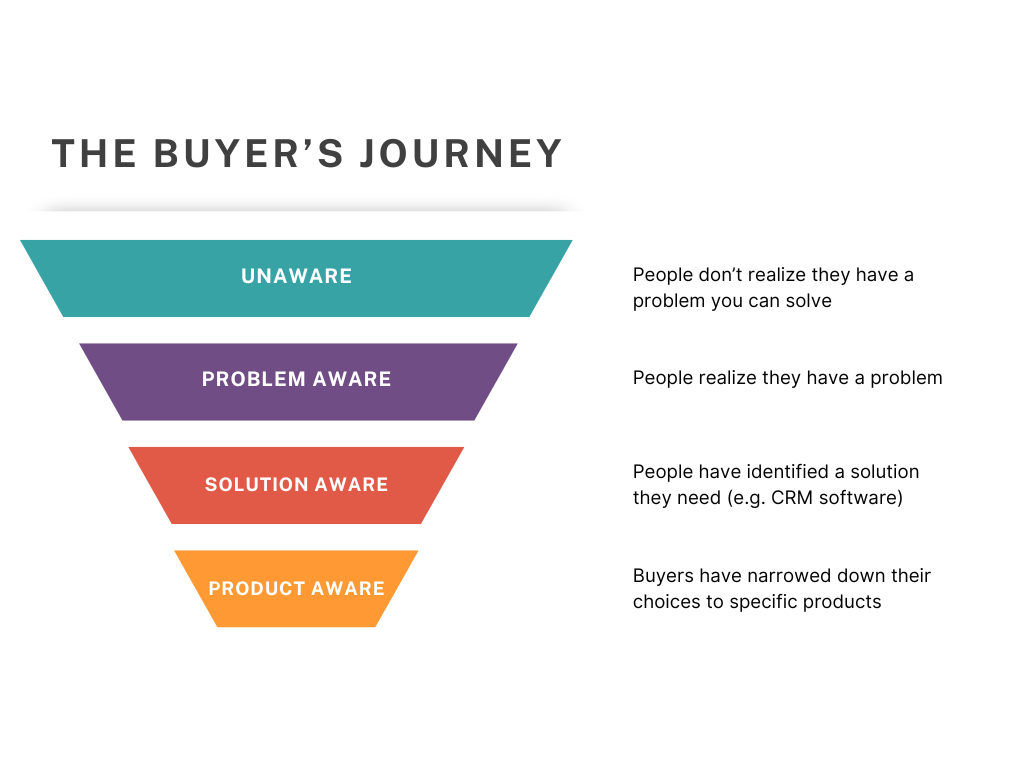
Each buyer falls into one of four categories of awareness as they progress from realizing they have a problem to deciding on a specific product to buy. These categories will guide your keyword selection:
Unaware
Buyers in the unaware stage don’t realize they have a problem that your SaaS product can solve, so they aren’t actively searching for anything directly related to that issue on search engines. This makes it challenging to reach them through SEO methods.
However, SEO can still play a role by targeting broad keywords that signal the searcher fits your ICP. The aim here is to educate your audience and help them recognize a problem they didn’t know they had. By offering valuable, insightful content, you can guide them toward becoming problem-aware. That said, social media is often more effective at reaching unaware buyers, so we generally don’t recommend relying on SEO alone for this stage.
Example keyword: How to become a VP of sales
Problem Aware
At this stage, your potential customers realize they have a problem but don’t know the best way to solve it yet. They’ll search for information about their pain points, which gives you an opportunity to guide them toward solutions you offer.
Example keyword: How to track sales follow-up
Solution Aware
These people have identified the type of solution they need but aren’t yet familiar with your specific product. They are actively searching for the best options available, often through comparisons or generic solution searches like “best CRM software.” This stage is a key opportunity to influence buying decisions, as these prospects are likely to request information about a solution that meets their needs.
Example keyword: Best CRM software for small businesses
Product Aware
In this stage, buyers are aware of your specific product and are considering it as a potential solution. They’ve likely narrowed their options to include your offering and are actively evaluating how it compares to competitors. At this point, they’re searching for information about your brand, product features, and customer reviews to finalize their decision.
Example keyword: [Your CRM Name] vs Salesforce CRM
These stages of awareness are based on a model popularized by Eugene Schwartz in his book Breakthrough Advertising. In his book, Schwartz includes a fifth stage called Most Aware, which refers to buyers who already know your product or a competitor’s product and are ready to make a purchase. By this stage, SEO should have done its job. For B2C SaaS, these buyers are ready for a free trial, while in B2B SaaS, they’re likely requesting a demo or more information. If you’ve gotten a buyer to the Most Aware stage, you’ve done your job in marketing! Now it’s time to collaborate with sales to ensure that this potential buyer becomes a buyer.
2. Set Your Objectives
After you understand how the buyer’s journey aligns with keywords, the next step is to define your business objectives. These objectives will drive your SEO strategy and help you measure success.
There are many possible objectives for an SEO strategy, but we recommend focusing on two main objectives:
- Drive awareness
- Drive revenue
Drive Awareness
If your objective is to get your brand in front of as many potential future buyers as possible, focus on driving awareness and targeting problem-aware individuals. These are people searching for keywords related to their challenges but who haven’t yet identified a specific solution.
These keywords typically see a higher number of monthly searches because more people realize they have a problem than those who have moved on to seeking specific solutions. By targeting these common pain points, you can position your SaaS company in front of a large audience and lead them towards a solution you offer.
Choosing awareness as an objective often means attracting more traffic to your site due to a higher number of monthly searches for these terms. However, these users are less likely to convert right away, as they are still exploring their options.
Drive Revenue
If your objective is driving revenue, focus on solution-aware customers searching for specific solutions but who haven’t picked a product yet. Keywords like ‘best CRM software’ or ‘top cloud storage tools’ target users who are actively considering options, making them more likely to convert. These keywords often have lower search volume compared to problem-aware keywords but have a much higher chance of generating sales, as the potential buyer has already decided on a specific solution.
Recommended Objective for SaaS SEO
For most SaaS companies, focusing SEO efforts on driving revenue is the most effective approach. By targeting solution-aware users, those actively searching for categories of products or services like CRM software, you increase the likelihood that your SaaS will be visible when potential customers are ready to make purchasing decisions.
For founders and executives, this revenue-driven focus helps demonstrate a strong return on investment (ROI) from SEO efforts, creating opportunities to reinvest in growth. For marketers, showing clear results through conversions from SEO can build more internal support and resources for future initiatives.
Whether your business is B2B or B2C, capturing high-value, solution-focused keywords ensures you’re positioned to meet your business objectives. Ultimately, showing up when potential customers are searching for solutions is the main goal of any SEO effort.
3. Establish Your Key Results
Once you’ve selected your objective and chosen the right keywords, it’s important to establish key results (KRs) to track your progress.
Recommended Key Results To Track:
For An Awareness Objective:
- Search positions
- Impressions
- Engaged sessions
For A Revenue Objective:
- Search positions
- Engaged sessions
- Annual Recurring Revenue (ARR) or Annual Contracted Value (ACV)
For both objectives, search position is a key metric for evaluating the technical success of your SEO. It shows how well your site ranks and indicates the strength of your optimization efforts. However, ranking first isn’t the goal. The goal is to drive a business result—whether it’s awareness or revenue. You might rank first for a keyword that doesn’t help achieve your goals if the keyword strategy was off from the start.
That’s why other metrics are essential for providing context on the quality of your SEO strategy and its impact on your business. For awareness campaigns, impressions indicate how many people see your content in search results, helping gauge your reach. That’s why additional metrics beyond search positions are necessary to evaluate the overall impact of your SEO strategy:
- Impressions: For awareness campaigns, impressions reveal how many people see your content in search results, helping gauge your brand’s reach.
- Engaged Sessions: This metric, relevant for both awareness and revenue campaigns, measures how many users actively engage with your content, giving insight into its quality and relevance.
- Revenue Metrics: For revenue objectives, tracking ARR (Annual Recurring Revenue) or ACV (Annual Contract Value) provides a direct measure of revenue impact. If you’re focused on shorter payback periods, monitoring Monthly Recurring Revenue (MRR) can also be useful.
By tracking key SEO metrics such as search positions, impressions, and engaged sessions for awareness objectives, or search positions, engaged sessions, and ARR or ACV for revenue-driven objectives, you’ll gain a comprehensive view of how your SEO efforts are driving business outcomes, beyond just keyword rankings.
4. Decide On A Search Engine Marketing Tool
Choosing the right keywords means balancing search volume, keyword competition, and the intent behind the search (e.g., whether the user is problem-aware or solution-aware). To start your research, you need a keyword tool to identify search terms that align with your marketing objectives.
Below are tools to help you with your keyword research:
Top Keyword Research Tools:
SEMrush
SEMrush is the gold standard for keyword research. It offers detailed insights into search volume, keyword difficulty, and competitor analysis.
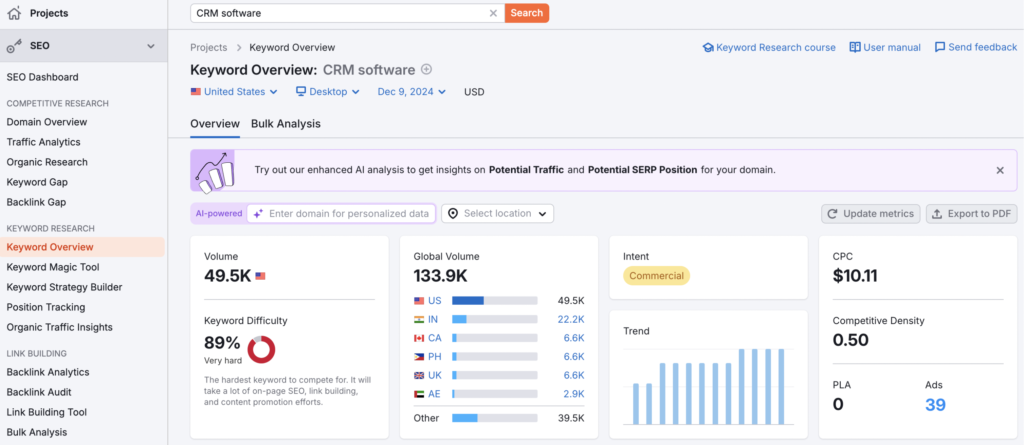
Screenshot above from SEMrush’s Keyword Overview Tool
Moz
Moz is a solid choice for tracking local and geographic-specific keywords. It’s more affordable than SEMrush while offering robust keyword tracking and SEO features. If your focus is on local search or you’re on a budget, Moz is a great option.
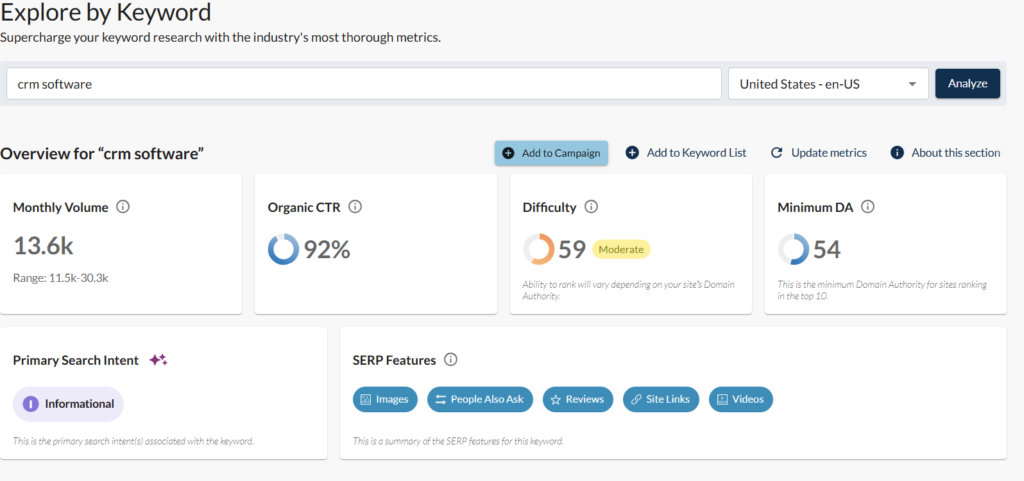
Screenshot above from Moz’s Keyword Explorer Tool
Google Ads Keyword Planner
Google Ads Keyword Planner is a free tool that helps you discover relevant keywords and track search volume. It’s a great starting point for basic keyword research. However, keep in mind that Keyword Planner does not provide a keyword difficulty metric, as it’s primarily designed for paid search rather than SEO. For insight into how difficult it will be to rank for certain keywords in organic search, you’ll need a paid tool like SEMrush or Moz
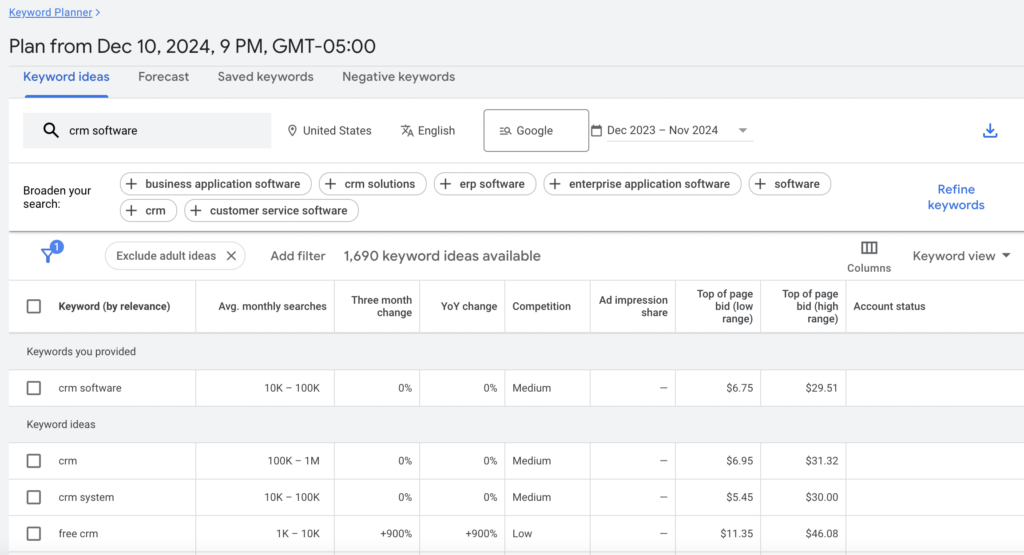
Screenshot above from the Google Ads Keyword Planner
Seeker tip: follow along
To get the most out of this guide, we recommend signing up for one of these search engine marketing tools so you can follow along with each step of the research process.
6. Do Keyword Research
Starting keyword Research:
Now that you’ve selected a search engine marketing tool, the next step is to create a list of keywords that would be beneficial for your company to rank for. If you’ve chosen a revenue objective, as we recommend, focus on solution-focused keywords. In SaaS, these often take the form of product categories and frequently include terms in the keyword phrase like software, solution, tool, and digital.
A good starting list might include 4–5 keywords relevant to your product offering. For example, if you offer CRM software, you might consider keywords like “CRM software.”
To start your research, input one of your target keywords into your search engine marketing tool. You’ll see a list of related keywords along with key metrics across several columns.
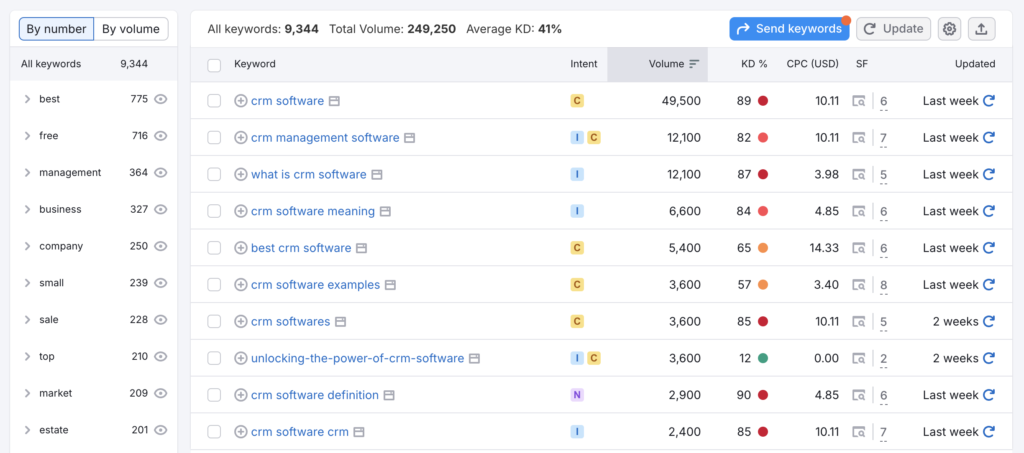
Screenshot above from SEMrush’s Keyword Magic Tool
For each keyword, pay attention to the following metrics:
- Search Volume (also referred to as Average Monthly Searches): This metric shows how many people are searching for the term each month.
- Keyword Difficulty (KD%): This indicates how challenging it is to rank for the keyword, based on factors such as competition and search engine results. In SEMrush and Moz, a lower number indicates an easier keyword to rank for. Google Ads Keyword Planner uses a competition score of low, medium, or high, but this is based on paid ads, not organic search. For an understanding of KD, it’s best to use a tool like SEMrush or Moz.
Identify Long-Tail Keywords To Start
When reviewing the list of related keywords to your starting keyword, look for those with a lower keyword difficulty score, which indicates less competition. These are often longer or more descriptive phrases, known as long-tail keywords in SEO.
Long-tail keywords tend to have lower competition but can still be valuable because they reflect more specific search intent from users.
For example, ‘CRM software’ has a Keyword Difficulty of 89 in SEMrush, indicating it will be tough to rank due to competition, even with strong SEO. In contrast, a more specific term like ‘CRM software for lawyers’ has a keyword difficulty of 24, making it a more achievable target.
While the search volume for “CRM software for lawyers” is lower, its specificity means that those searching for it are more likely to convert and as the competition is lower you have a better chance of ranking for the keyword.

Screenshot above from SEMrush
Over time, as your website gains authority, you can target more competitive keywords like “CRM software.” But initially, it’s best to focus on more manageable long-tail keywords, targeting around 5-10 of these.
The only exception to this rule is for established companies with a strong brand and dedicated SEO resources. In those cases, you should go after high-volume solution keywords, even if the keyword difficulty score is high.
Seeker tip: check which companies rank for your target keywords
When selecting long-tail keywords, take note of the websites ranking for them and ask yourself: are they your competitors? If you’re not seeing companies that resemble your competitors in the search results, it could indicate that the keyword doesn’t align with your target audience. This mismatch can lead to attracting visitors who are less likely to convert into customers, reducing the effectiveness of your SEO efforts.
5. Do A Keyword Gap Analysis
After identifying your 5-10 long-tail keywords, the next step is to perform a keyword gap analysis. This process helps you find additional target keywords that your competitors rank for, but you don’t.
Tools like SEMrush or Moz make it easy to compare keywords your domain ranks for against competitors. You can input your known competitors and also use the competitors you discovered during your initial keyword research.
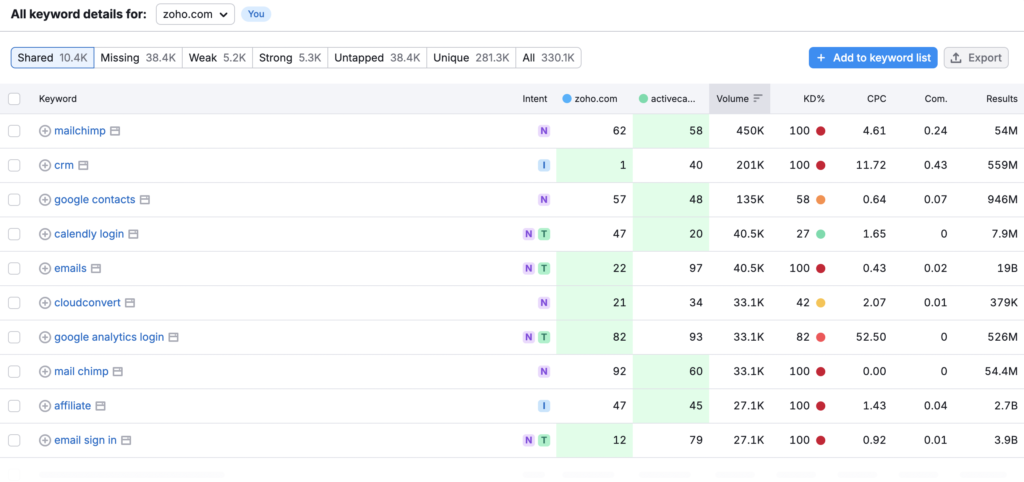
Screenshot above from SEMrush’s Keyword Gap Tool
For example, if a competitor ranks well for “CRM software for small businesses,” this may be a keyword you want to rank for too. Focus on low-difficulty, high-reward keywords like these, where it’s easier to compete (as indicated by keyword difficulty or similar scores). Add these keywords to your working list.
6. Organize Keywords Into Topical Groups
Once you’ve finalized your keyword list, organize the keywords into related topic groups. For example, if you offer CRM software, you could create a topical group focused on small businesses with keywords like “best CRM for small business,” “affordable CRM for small business,” and “sales software for small business.” This strategy builds topical authority, which is crucial for improving search rankings. According to a mid-2023 Google API leak, Google uses a site focus score to evaluate how well a website covers specific topics. Consistently publishing content on related subjects increases your chances of ranking higher in search results.
7. Create A Content Plan
After grouping your keywords, prioritize the groups based on the business value they are expected to generate. Begin by creating content focused on the keywords in the highest-priority topic groups, then move on to the next group.
Seeker tip: one page can rank for multiple keywords
To check if you can target several keywords with one page, do a quick Google search for each term. If the same content ranks for several of the keywords, plan to target all those keywords with a single page. This will save your content team time and improve your chances of ranking the page on Google.
8. Create Content That Ranks
Analyze SaaS Competitors and Create Content Requirements
Before creating your content, analyze the top three search results for your target keyword. Focus on these key aspects:
- Headlines: Pay attention to the H1 and subheadings, as these structure the content.
- Meta titles & descriptions: Observe how they are crafted and what information they highlight.
- Word count: Record the word count for each page.
- Keyword density & usage: Observe how often keywords appear and where they are placed within the content.
- Media elements: Identify the types of media used—images, videos, infographics, etc.—and analyze how frequently each type of content appears.
Use this research as a blueprint for your content. Aim for a similar structure, theme, length, and user experience to what’s currently ranking, while also adding unique value.
How to use your competitor research to create content:
- Meta title & H1s: Structure your meta title and H1s similarly to top-ranking results. For example, if a top-ranking page has the meta title “What Is CRM Software? A Comprehensive Guide,” consider using something like “What Is CRM Software? The Definitive Guide.”
- Subheadings: Ensure your content covers all major themes addressed by your competitors in their subheadings (H2s and H3s).
- Word count: Aim for a word count about 20% longer than the top result, giving you room to add depth and detail.
- Keyword density: Target around 20% higher keyword density than the leading page, as long as the keywords fit naturally into your content.
- Media elements: Include the same types of media, and try to use around 20% more than your competitors.
- Look for information gaps: identify gaps or areas where your competitors fall short on explaining aspects of the topic, and provide more detailed and valuable content in those areas.
The best indicator of what will rank well is what is already ranking. By conducting a thorough competitor analysis and modeling your content on these findings, you will set yourself up for success in search engine results.
Use Semantically Related Keywords In Your Content
While analyzing competitors, take note of the keywords they use that are semantically related to your target keyword. Semantically related keywords are words or phrases that are closely linked to your target keyword. Search engines like Google utilize these related terms to assess the quality of your content. For example, if you have a blog about “CRM software” but don’t include related terms like “customer relationship management,” “sales pipeline,” or “lead tracking,” search engines may not rank your content as highly because it lacks important keywords found in top-ranking articles.
Tools like ChatGPT, SEMrush, and Google’s ‘People Also Ask’ and ‘Related Searches’ can help you discover these related terms. Incorporating them into your content will improve your webpage’s relevance to your target keyword and enhance its chances of ranking on Google
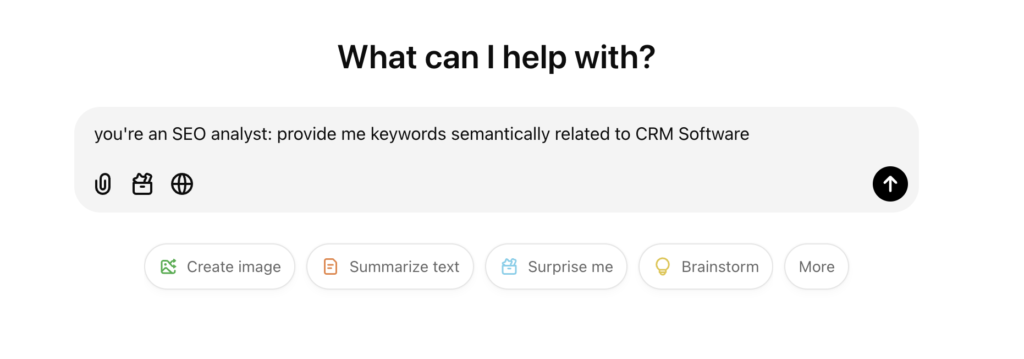
Follow Google’s E-E-A-T Guidelines
E-E-A-T stands for Experience, Expertise, Authoritativeness, and Trustworthiness. This framework is used by Google’s quality raters to evaluate the quality and trustworthiness of content on the web. Adhering to these guidelines can significantly boost your site’s ranking on Google by aligning your content with Google’s standards for high-quality information.
- Experience: Demonstrate firsthand experience with the topics discussed. For instance, include case studies or personal insights that validate your expertise.
- Expertise: Showcase the knowledge of your team. This could involve sharing articles, research, or insights that highlight your qualifications in the industry.
- Authoritativeness: Build a strong reputation through mentions on respected sites and positive reviews. Being cited by industry leaders can enhance your authority.
- Trustworthiness: Ensure that your content is accurate, well-researched, and uses credible sources.
For SaaS companies, demonstrating E-E-A-T helps you stand out in competitive markets by building credibility with both users and search engines.
Place The Target Keyword In The Headline
Make sure you include your target keyword in your first headline or the H1 headline. Your competitor research should have already led you down this path, but it’s worth checking, as this is one of the most important signals to search engines that your content is relevant to a user’s search query.
Keyword Usage
Use insights from your competitor analysis to guide your keyword placement and usage. As a rule of thumb, include your target keyword in the first sentence of your content, ideally at the beginning of the sentence.
9. Do Technical SEO
Technical SEO is the process of optimizing a website so search engines can find, crawl, and index your pages effectively while enhancing user experience. A smooth user experience is necessary because search engines like Google track user behavior, and high bounce rates can negatively affect rankings. Addressing these technical issues helps search engines understand your site better and prevents users from leaving due to poor performance.
Here’s how to improve your technical SEO:
Address Page Speed
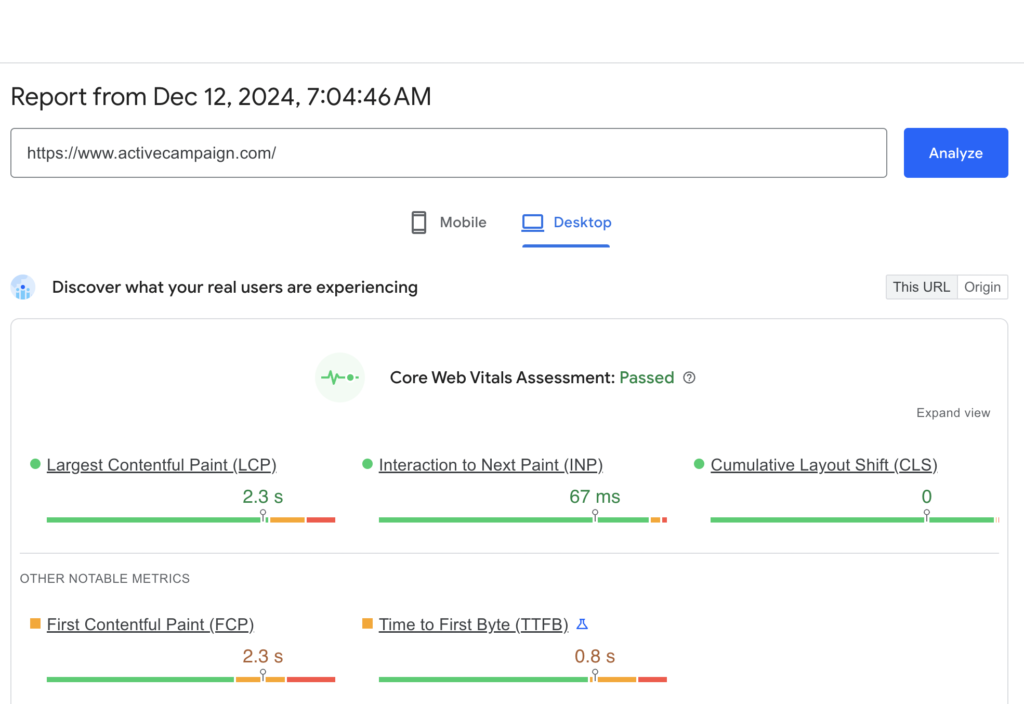
Google has used page load speed as a ranking factor since 2010, and in 2018, it updated this to include mobile speed. A site that takes longer than 3 seconds to load risks losing 53% of mobile visitors. Use Google PageSpeed Insights to check your site and make sure both mobile and desktop versions are optimized for fast loading.
Analyze Mobile Friendliness
With mobile-first indexing, Google uses your site’s mobile version for ranking. Make sure your site is responsive and works smoothly across all devices. Use Google’s Mobile-Friendly Test to ensure it performs well.
Check Meta Tags
Meta titles are the clickable headlines people see in search results, and they should clearly describe what your page is about. Meta descriptions are the short blurbs beneath the title, summarizing your content and encouraging users to click through to your site. Your meta tags should clearly describe each page and include your target keywords
Add Alt Tags
Alt tags (or alternative text) are hidden descriptions in the HTML code of an image on your website. They are not visible to users unless the image fails to load, but they serve two important purposes: accessibility and SEO. For visually impaired users, screen readers will read the alt text to describe what the image is about. For search engines, alt tags help identify and index images, improving your site’s ranking potential.
Including relevant keywords in alt tags can improve your search positions by ensuring that search engines understand the content of your images.
Monitor for Errors
Regularly check for 404 errors and broken links using Google Search Console. A 404 error happens when someone tries to visit a page on your site that doesn’t exist anymore. It’s like opening a door to find nothing behind it. Fixing these errors helps improve the user experience and keeps your site in good standing with search engines.
Focusing on these technical SEO areas will help boost your site’s rankings and improve user engagement.
10. Create Internal links
Internal linking is the practice of linking one page of your website to another. Internal links should be created strategically, as they help visitors navigate your site and assist search engines in understanding how your site is organized. Search engines use these links to find and understand your pages. Generally, the more internal links a page has, the more search engines see it as valuable and important, helping improve its ranking.
Best Practices for Internal Linking:
- Use Your Target Keyword In the Anchor Text: The clickable text in your links (called anchor text) should include relevant keywords for the page being linked to. For example, if you want to rank for “best CRM software,” use that phrase as your anchor text when linking to that page.
- Place links in high value areas: Place links to high-priority pages in prominent areas like the homepage, footer, and navigation menu to signal their importance to search engines.
- Link Naturally: Ensure your internal links are relevant to the content they appear in, which improves user experience and helps search engines better understand the context of the linked pages.
11. Start Offsite SEO: Create A Link Profile For Your SaaS Company
Offsite SEO focuses on activities outside your website that enhance its credibility and search engine rankings.
The core of offsite SEO revolves around acquiring backlinks, or links from other websites to your content. Google originally based its PageRank algorithm on backlinks, treating them as a vote of confidence from one site to another. While backlinks aren’t the only ranking factor, they remain a key element of SEO today.
Key Offsite SEO Tactics:
- Backlink building: Secure links from high-quality, authoritative sites to boost your SEO rankings. Links from reputable sites like CNN are more effective than those from lesser-known sites. You can acquire these backlinks through PR pieces, guest blog posts, business profiles, and comments.
- Software review websites: Create profiles on key SaaS review sites like G2, Capterra, GetApp, and Software Advice. Paid options can generate valuable backlinks and increase your visibility in the SaaS marketplace.
- Brand mentions: Mentions on reputable sites can help build authority, even without direct backlinks. For example, if your software is highlighted in a Forbes article, it signals to search engines that your brand is recognized, boosting your SEO indirectly.
By leveraging these offsite SEO tactics, you can build authority, boost visibility, and achieve better rankings than with onsite SEO alone.
Seeker tip: leverage your anchor text
When creating backlinks, pay attention to the anchor text. It should ideally be your target keyword or a closely related term. Google reads this anchor text to understand the context of the linked page and considers the words surrounding it. To leverage this, place your brand name close to the anchor text. Over time, this practice will help Google build an association between your brand and your target keyword, ultimately improving your SEO performance.
Building Long-Term Growth Through SaaS SEO
Effective SaaS SEO isn’t just about quick wins, it’s about regularly improving your approach for long-term growth. Track your progress against your goals, whether that’s building awareness or driving revenue, and use key metrics like search position, impressions, engaged sessions, and ARR to guide your adjustments. As Eisenhower said, “Plans are useless, but planning is indispensable.” This guide provides a framework for planning, but know your actual plan will need to adapt as you put it into practice. Focus on what works, find areas to improve, and adjust as you go. With a solid, adaptable approach to SEO, you can attract your target customers, lower acquisition costs, and build a strong presence in your market. Keep refining your efforts until they deliver the growth you’re looking for.





